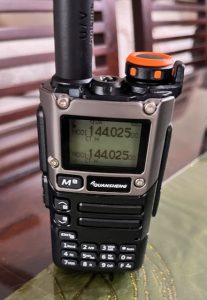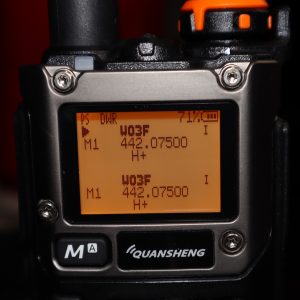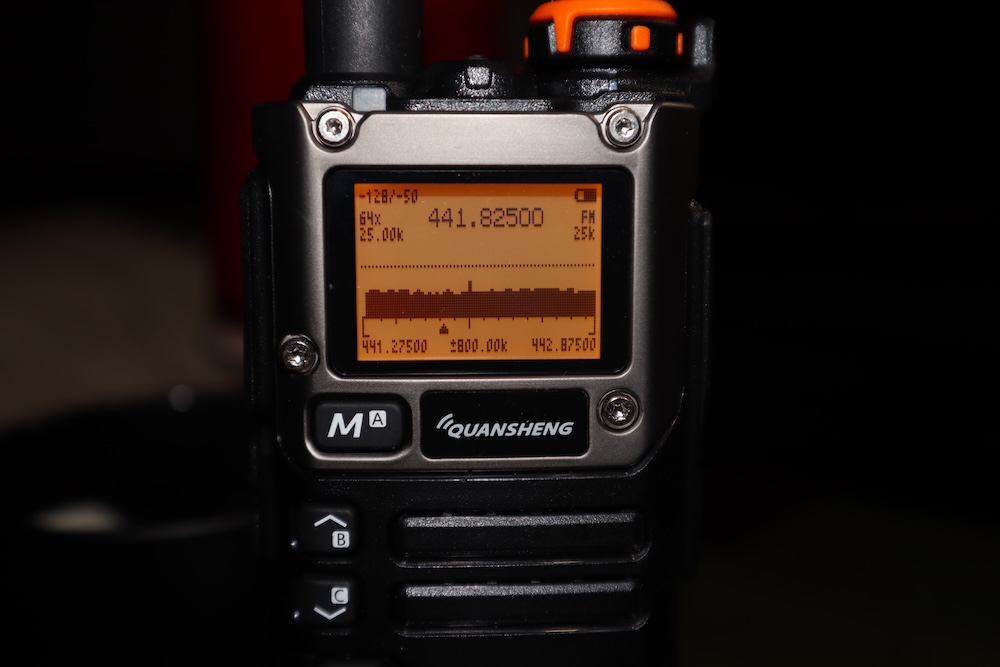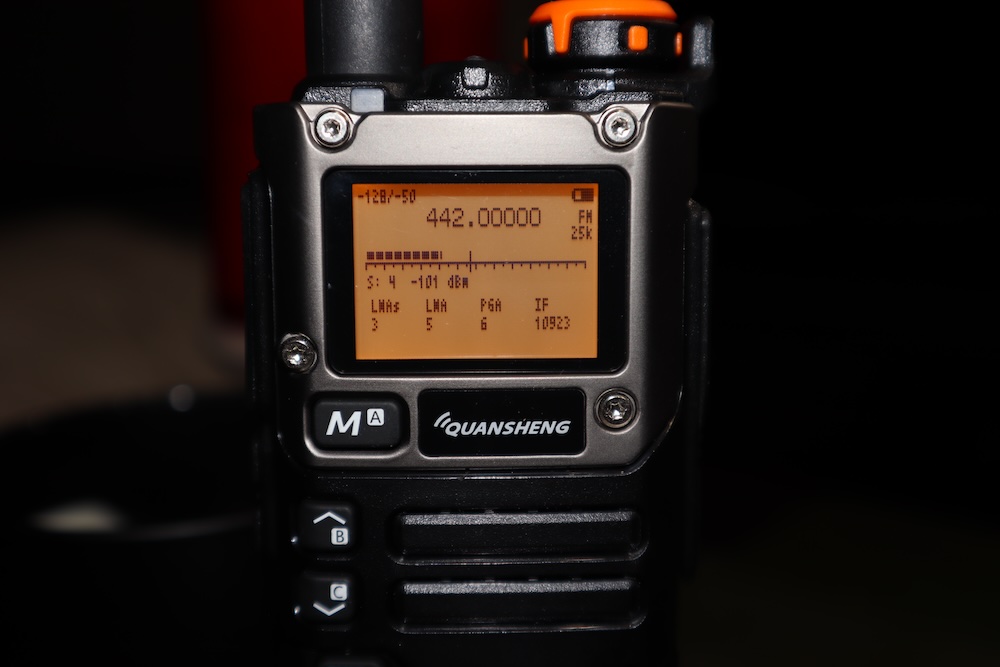Quansheng UV-K6 Radio Review

Quansheng UV-K6
I own several handheld VHF/UHF radios. Some are for Digital Mobile Radio (DMR) but all do analog or simplex frequencies. I think just about all of us cut our teeth on the Baofeng UV-5R. I’m no exception. I think I have 2 or 3 around the house here somewhere. On a whim I decided to buy a Quansheng UV-K6 radio which also is designated as UV-K5(8). FCC ID information can be found here.
I recently purchased a Wouxun KG-Q10H which I really feel is the best handheld I’ve owned so far.
The only reason I picked up this Quansheng UV-K6 was for its ability to flash open source firmware onto it. Additionally, the radio can be unlocked to transmit on a whole slew of bands.
The bad news here is that of course is against FCC Regulations. Secondly, because the radio is a VHF/UHF radio, transmitting on any band other than those will be done in milliwatts. So not only are you breaking the FCC rules, you aren’t really doing anything but spraying out weak transmissions with tons of 2nd and 3rd order harmonics. In fact I’d recommend NOT unlocking the all the frequencies. There is a difference between unlocking the radio and unlocking all frequencies. Those are two separate actions or steps. Don’t unlock the transmit frequencies so you don’t accidentally do anything illegal.
Despite all this the radio is SOOOOOO hackable as to be almost irresistible to a guy like me.
Initial Observations
There are 6 ham repeaters near me that I program in to every radio I own. I can generally hit 4 of them with most radios. The other 2 can be hit given good conditions but usually requires me to stand in the magic spot in the yard and point the antenna towards the tower.
The Quansheng UV-K6 just does not stack up as well as most of my other radios. One YouTuber calls this “fars”. Like bars on your cell phone. “How many fars can you talk?” The answer with this radio is “not far”. It just doesn’t hit but a couple of those repeaters. Two more will hit but with horrific crackling and static, and the last two just aren’t reachable at all from my house.
So again, I give props to the Wouxun KG-Q10H which is still the best so far.
The Quansheng UV-K6 looks and feels cheap but of course it is cheap. I paid $30 for mine whereas the Wouxun costs $219. So no real surprise there.
And as a bonus the Quansheng UV-K6 can be programmed with CHIRP software.
Original OEM Firmware
Original firmware updates (and manuals) can be found towards the bottom of this page.
Custom Firmware
The real allure with this radio is the ability to load open source firmware on them. There are a few popular firmwares out there for this radio. One is called Egzumer and this is the firmware I am currently testing. Right now it is on version 0.22 at the time of this writing. Another popular firmware is IJV. Current version of IJV is 2.9R5. I just got a 2nd UV-K6 and installed IJV on it. It’s okay, but without getting too deep in the weeds I think I like egzumer firmware better. Still I mostly use this radio for Air Band scanning and it performs flawlessly doing that with IJV firmware.
Also of notable mention is a firmware from F4HWN. It is based on Egzumer however, to me, it seems to be the most powerful with the most tricks.
All of these firmwares have left out potential features due to the limited amount of on board memory space available. Sure will be cool if the next iteration of this radio has a ton more memory for firmware.
Obviously, the custom firmwares provide features that the original firmware does not offer. And those features are too numerous to list. There is a good list on the Egzumer Github page. I’ll just mention a couple of the features here.
But First The Chipset
The radio is based on a Beken BK4819 chip. The same chipset is used in baby monitors and toys. Chip frequency spread is advertised as:
• Worldwide band: 18 MHz ~ 620 MHz, 840 MHz ~ 1200 MHz
The radio itself however is advertised as operating from 50 MHz to 600 MHz. Much of that space being used for reception. Applying a firmware mod can unlock transmission outside of 136-174 MHz (VHF) and 400-520 MHz (UHF).
Again, I don’t think it as much people wanting to break the rules as it simply is just that they CAN HACK THE RADIO. It’s like climbing a mountain because it is there.
Spectrum Analyzer
Now this is a neat trick. One item of note though is that this is for reception only. While turning on the spectrum analyzer I was involved in a ham radio net on VHF and realized while it was enabled I could not transmit. The spectrum analyzer is for receive only.
Spectrum Analyzer (click pics to enlarge)
Receiver Functions
Upping to a custom firmware can get you some CB radio reception which is pretty cool if you are into that kind of thing. Transmission tests on the CB band I’ve seen show super low output power and spraying RF. In fact 2nd, 3rd, and 4th level harmonics were intruding on some dangerous turf like Air Band.
Don’t push that PTT button on CB radio frequencies. Just don’t transmit out of the legal VHF and UHF bands. Don’t do it!
For Air Band be sure and set your Discriminator Function (Menu Item 13) to AM. I thought Air Band reception was hosed. Mine had super advanced static and was scratchy. And then it flashed in my mind in the middle of the night that those comms are AM. Sounds really good once I flipped Menu item 13 to AM.
Other Upgrade Niceties
You can add a battery percentage to the main screen which is cool. You can also display channel name + frequency which is double cool.

Name + Freq and Battery Percentage shown
And you can do backlight dimming. Actually there are so many features that are added in custom firmwares that you’ll spend hours running them all down. I have barely scratched the surface here and only mentioned a few that I think are beneficial to ME.
There is a fix for AM (item 56 in th menus) that greatly improves Air Band reception. I live fairly close to an airport and sometimes it is fun to listen to the tower comms.
Power Tests
Does it put out the proper wattage? Pretty close and pretty much mirrors the results on a lot of other 5 watt radios. Quick video below.
[kad_youtube url=”https://youtu.be/uJbjIFb-jAc” ]
Should You Buy This Radio?
I’m torn. Quite frankly, it isn’t even close to being the best handie talkie out there. As I’ve noted it doesn’t seem to have the range (UNDER MY CONDITIONS) that some of my other radios have. I should note that I have not tested any other antennas on the Quansheng UV-K6 up to this point.
Last night while on a local repeater ham radio net I had to go outside on the porch with this radio to have solid comms. Most of my other radios can hit this repeater indoors with a good solid signal. Again, as that YouTuber says, “How many fars will it talk?”. Answer again: Not many. And isn’t that why we buy radios?
All this being said, if you live in a good reception area with lots of repeaters you may not have the challenges I do. I live in the woods, surrounded by trees and I’m barely above sea level.
If you live in a good reception area and don’t need to punch VHF through the trees then doesn’t it make sense to use a $30 radio versus a $220 radio? I think that it probably does.
As always………Should you buy it? It depends on your situation and your needs.
A lot of hams are like me and will buy it just so they can play with it and complain about it not being the greatest radio ever. Hey, what do you want for $30?
Finally, the ability to hack this radio with all manner of custom firmwares is enticing. Especially at this price point. Opening up all those transmit bands could get a fella in trouble. I have opted to apply the Egzumer firmware but to NOT unlock the transmit function on additional frequencies or bands. There is no benefit to doing it, in my opinion. And there is a whole lot of downside to doing it.
Do buy this radio if:
- You collect radios
- You like tinkering around under the hood AND understand all the rules and regulations
- You live in a great reception area with a clean shot to your repeaters
Do not buy this radio if:
- You live in a challenging reception area
- If you are a new ham and don’t understand all the ins and outs of hacking this thing
- You want the very best radio money can buy
Well, I bought one and I’ll surely keep it, but pretty sure after this week of testing it will become a dust collector.



Regarding “fars.” :).
Saw a Hungarian (I think it was) video where egzumer had trouble hearing a far far away repeater (155km??) but the IJV loaded Quansheng came in legibly.
So just maybe there are tradeoffs in toys vs function in these firmwares, and picking is more important than just the eye candy bits.
My radio is coming in a few weeks, and I think I will start with IJV 3.xx, first, then egzumer for the spectrum toy.
Great radio. I have modified many of them. The one thing that does stand out though when using the egzumer software, is that at the lower frequencies, particularly 27MHz, the radio does not pick up a thing. I’ve done quite a few tests with other scanners Vs the Quanshengs, and they just can’t pick up anything at the lower frequencies. Strange really as they work great everywhere else.
Nekem 2-3 héten belül érkezik ez a rádió. A repülőgépek és a rendőrségi, mentős, tűzoltós forgalmazásokat szeretném hallgatni vele. A taxikat is le lehet hallgatni? Lehet ezzel telefonálni ingyen? Bocs a hülye kérdésekért. Érdekel a téma.
Thought I’d drop a note. I’ve decided to run with F4HWN firmware currently V3.2 and am very happy it allows FM, AM & USB, with fine granulation in frequency and power steps. For those who would like to know sensitivity it’s ok between 50 – 600Mhz but rapidly drops off outside these frequencies. Power output is OK between 100 – 550Mhz with 5.4W at 145Mhz & 4.4W at 430Mhz. It can transmit from 20Mhz through to 1000Mhz but is down to uW so totally unusable. It’s my opinion that firmware versions will not change this. A receiver mod is available to allow it to cover all the HF band at reasonable sensitivity.
Overall In my opinion the firmware turns an average hand held into one of the best handhelds I have ever used, there is a limitation of 200 memories, but can be programmed with Chirp with what is called a ‘driver’ add on.
Does anyone know if this radio can recive broadcast AM? There are still a few AM stations around here I like to listen to.
HT sometimes have broadcast FM which is nice. If this had that while also AM it would be very nice.
Does this radio have the NOAA alert function? Tune to your local weather station, radio goes to sleep but wakes up when there is an alert?
Yes – this radio can receive broadcast AM.
Great post, my UV-K6 (K5 upgraded?) doesn’t look like yours, the AM function is item 46 or 47 in the menu, the users manual says 47, the radio has AM on 46, but it sounds broken up. As I talk on the radio transmitting the K6 RX meter drops out/off, Freq. 118.000, I have a Yasu VXA-700 to transmit with and it sounds ok on a TIDRADIO TD-H3..
I purchased two UV-K6 variants for experimentation. Currently both sets are running the OEM firmware and I have been testing them on UHF in simplex (back to back) mode & I have also experimented with the ten point voice inversion scrambler for interests sake.
The radios output about 4.5 watts which is as expected, however at UHF the noisy receivers are a real letdown. In practical terms the maximum range between two sets on simplex is no better than PMR446, which is limited to 0.5 Watts. Changing the antennas does not improve things much.
Regarding the scrambler, I have found that this will only work on the higher point settings, that is 7-10. Below 7 an annoying beat note becomes evident. This is despite turning off CTCSS & DCS to create a ‘clean’ signal.
I will get around to testing them on VHf too but I am not expecting much. Maybe a firmware flash will improve things, but I suspect the hardware is not up to much.
So John this seems to nicely backup your experience with the local repeaters.
As to whether it’s worth buying one, I thinks it’s a case of “let the buyer beware”!
73’s
I think you are correct. It matters what you want from the radio. For me it is the best hand held for its super low price for receiving only. And in terms of receive strength. I have been comparing a Quansheng with my AOR AR8000 and they are almost identical in terms of receive strength. That’s with the same settings, same antenna etc.
Which HT would you recommend, with good quality, good range, at a low cost, for use in rural areas?
There are so many and so many variables. I like the Wouxun KG-Q10H and have two for local comms.